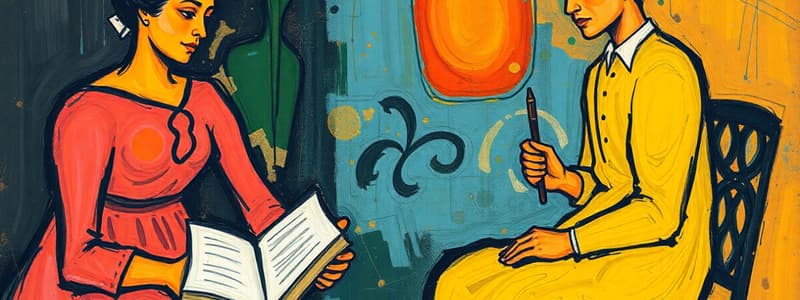Podcast
Questions and Answers
Match the racial categories used in the Philippines with their descriptions in the context of the late 19th century:
Match the racial categories used in the Philippines with their descriptions in the context of the late 19th century:
Peninsulares = Spaniards born and raised in the imperial center, holding the highest positions. Criollos = Spaniards by descent born and raised in the Philippines. Mestizos = Individuals of mixed parentage, often with Spanish or Chinese ancestry. Indios = The native population, who were at the bottom of the social pyrimid.
Match these political terms with their meanings or associations in Rizal's Noli Me Tangere :
Match these political terms with their meanings or associations in Rizal's Noli Me Tangere :
Nación = Corresponds to a broad sense of people, country, or ethnic group. Seldom directly refers to the Philippines as a nation. Patria = Ranges in meaning from home-town to native land and is often used in a general sense applicable to others' motherlands. Pueblo = Refers to a small-scale human habitation or the human beings living there, often unspecified townships around San Diego or Manila. Nacionalismo = Notably absent from the text, showing a limited development of a modern sense of Filipino nationhood.
Match the characters in Noli Me Tangere with their association to the Tagalog language:
Match the characters in Noli Me Tangere with their association to the Tagalog language:
Narrator = The largest user, often adding Spanish paraphrases for a broader non-Filipino audience. Elias = Notably does not use Tagalog despite being a representative hero of the oppressed, speaks 'perfect Castilian'. P. Dámaso = Uses Tagalog in a contemptuous or comic manner, often creolized phrases. La Consolación = Speaks ‘perfect’ Tagalog in one instance, but is typically pretentious about not understanding the language.
Match the linguistic strategies employed by characters in El Filibusterismo with their implications:
Match the linguistic strategies employed by characters in El Filibusterismo with their implications:
Match these themes discussed in the provided text with their relevance Noli Me Tangere by José Rizal:
Match these themes discussed in the provided text with their relevance Noli Me Tangere by José Rizal:
Match each character from El Filibusterismo with elements related to their identities.
Match each character from El Filibusterismo with elements related to their identities.
Match the literary/social implications highlighted in the provided text, to the linguistic and rhetorical shifts between Noli Me Tangere and El Filibusterismo.
Match the literary/social implications highlighted in the provided text, to the linguistic and rhetorical shifts between Noli Me Tangere and El Filibusterismo.
Match each term with its description reflecting nuances about the Spanish colonial context of 19th-century Philippines.
Match each term with its description reflecting nuances about the Spanish colonial context of 19th-century Philippines.
Match each item/argument from the text with observations about how language is deployed.
Match each item/argument from the text with observations about how language is deployed.
Match Rizal's views in Under Three Flags to conclusions drawn in textual explorations from the provided text!.
Match Rizal's views in Under Three Flags to conclusions drawn in textual explorations from the provided text!.
Flashcards
Philippine Colonial Society
Philippine Colonial Society
Colonial society in the Philippines was viewed as a 'racial' pyramid, with biological, ethical, and economic distance increasing from a metropolitan norm.
Peninsulares
Peninsulares
Spaniards born and raised in the imperial center,
Criollos or Creoles
Criollos or Creoles
Spanish by descent but born and raised in the Philippines, believed to have been affected by the local climate and culture.
Mestizos
Mestizos
Signup and view all the flashcards
Chinese in the Philippines
Chinese in the Philippines
Signup and view all the flashcards
Indios
Indios
Signup and view all the flashcards
Sangleyes
Sangleyes
Signup and view all the flashcards
Moros
Moros
Signup and view all the flashcards
Pagan Tribes
Pagan Tribes
Signup and view all the flashcards
Peninsular (in Noli)
Peninsular (in Noli)
Signup and view all the flashcards
Criollos (In Noli)
Criollos (In Noli)
Signup and view all the flashcards
Mestizo(s) in Noli
Mestizo(s) in Noli
Signup and view all the flashcards
Indio in Noli
Indio in Noli
Signup and view all the flashcards
Chino in Noli
Chino in Noli
Signup and view all the flashcards
Moros In Noli
Moros In Noli
Signup and view all the flashcards
Pagan Populations In Noli
Pagan Populations In Noli
Signup and view all the flashcards
Tagalo / Tagalogs In Noli
Tagalo / Tagalogs In Noli
Signup and view all the flashcards
Ilocanos in Noli
Ilocanos in Noli
Signup and view all the flashcards
España in Noli
España in Noli
Signup and view all the flashcards
Patria in Noli
Patria in Noli
Signup and view all the flashcards
Pueblo in Noli
Pueblo in Noli
Signup and view all the flashcards
Libre In Noli
Libre In Noli
Signup and view all the flashcards
Rey [King] In Noli
Rey [King] In Noli
Signup and view all the flashcards
Partido In Noli
Partido In Noli
Signup and view all the flashcards
Filibuster In Noli
Filibuster In Noli
Signup and view all the flashcards
Progreso In Noli
Progreso In Noli
Signup and view all the flashcards
Sociedad word
Sociedad word
Signup and view all the flashcards
Ciudadano
Ciudadano
Signup and view all the flashcards
Revolucion in Noli
Revolucion in Noli
Signup and view all the flashcards
Study Notes
- The book Why Counting Counts focuses on studying forms of consciousness and language problems in José Rizal's novels, Noli Me Tangere and El Filibusterismo.
- Benedict R. O'G. Anderson is the author.
- Ateneo de Manila University Press published the study in cooperation with Philippine Studies.
Copyright Information
- Copyright 2008 is held by Ateneo de Manila University and Benedict R. O'G. Anderson.
National Library of the Philippines CIP Data
- The book suggests a simple way to understand Noli Me Tangere and El Filibusterismo to deepen the understanding of Rizal's perspective and the socio-political context in which they’re set.
- A recommended entry suggests this is a study of forms of consciousness and problems of language in Noli Me Tangere and El Filibusterismo.
- The ISBN is 978-971-550-555-0.
Acknowledgements
- The author expresses gratitude to Jun Aguilar, Neil Garcia, Bomen Guillermo, Carol Hau, Ambeth Ocampo, and Tony Wood for their insightful feedback.
- The author assumes responsibility for any errors or misinterpretations.
- The articles in this book were previously published in Philippine Studies.
A Brief Word to the Reader
- The book is for Filipinos, especially students and teachers, who know Rizal's novels' plots, characters, and locations.
- Provides a simple method for understanding Noli Me Tangere and El Filibusterismo, Rizal's evolving perspective, and their complex politico-cultural context.
Introduction
- Critical writing on Rizal's novels often overlooks the author's intended audience and the complexities of race and ethnicity.
- There is a habit of quoting phrases out of context and neglect of the character intentions, which can make the books seem like ethico-political treatises.
- This introduces a systematic study of elements in vocabulary, style, and context, treating the works as novels.
- The study aims to comparatively analyze Noli Me Tangere and El Filibusterismo.
- The texts uses analytical methods and formats to compare the data on both novels.
Noli Me Tangere
Spanish-Colonial 'Racial' Strata and Ethnicity
- Colonial Philippine society was theoretically organized as a 'racial' pyramid, reflecting social and biological distance from a European norm.
- Highest were the peninsulares, Spaniards born in Spain.
- Below them were the criollos or creoles, Spaniards born in the Philippines.
- Mestizos were of mixed parentage.
- The Philippines was distinct, containing a large population of immigrant Chinese and their descendants, hence the need to differentiate between Spanish and Chinese mestizos.
- At the base were the indios.
- 'Ethnicity' emerged as a census category after American colonization.
- The Spanish regime used differential tax and legal statuses to enforce this social hierarchy.
- Significant groups outside the pyramid include non-Catholic Chinese (sangleyes, later chino), unsubdued Muslims, and pagan tribes.
- The term peninsular appears four times, spoken by the Teniente and the Narrator.
- Criollos is even rarer, the male form used once by a friar and the female form by the Narrator.
- Mestizo(s) occurs four times, often specified as español(es).
- Mestizo chino is absent, despite their influence; the Narrator mentions mestiza twice and P. Dámaso uses mesticillos.
- Indio is common, used by all levels of society, numbering 43 mentions with P. Dámaso using it 13 times and the Narrator 7.
- Naturales, a synonym for indio, appears 5 times, split between the Narrator and Don Filipo.
- Chino is frequent, appearing 35 times as a noun and widely distributed. The elderly sangleyes are used only once and by the narrator.
- Moros are mentioned three times by the Narrator and refer to characters in a moro-moro play, not to Muslims.
- Tagalog as a language, but tagalos are mentioned in the Narrator's commentary only five times.
- The complete absence of the Ilocanos, was a strange discovery.
- The novel usually ignores the diverse Filipinos.
Political Vocabulary and Concepts
- España mainly refers to the Iberian country, but the Capitan-General uses it for the Empire and occurs 39 times.
- Español should have an obvious meaning but people born in Spain are not the referent.
- Filipinas is mentioned 59 times, with a wide distribution throughout the story.
- Nacion, patria, and pueblo refer to the Philippines.
- Nación crops up seven times, nacionalidades occur twice, nacionales are used once, and the adjective nacional occurs twice.
- Rizal only used the word nation nine times.
- For instance, Ibarra tells Tasio that every man should love his mother country.
Studying That Suits You
Use AI to generate personalized quizzes and flashcards to suit your learning preferences.




